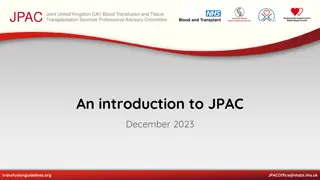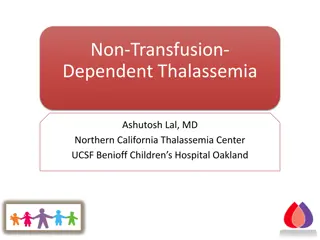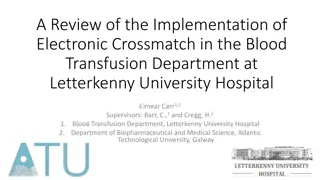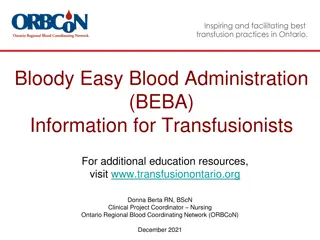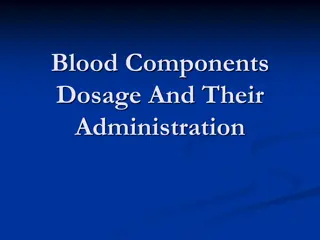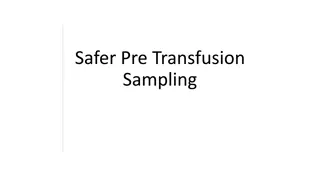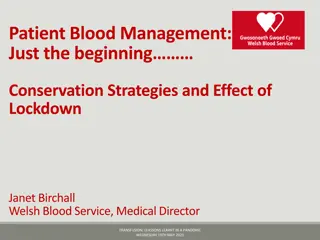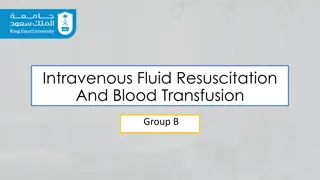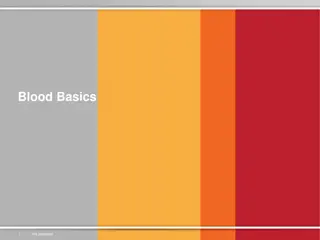Ensuring Patient Safety in Blood Transfusion Services: Standards and Concerns
Hospitals providing Transfusion Medicine services must adhere to established standards to ensure patient safety and product efficacy. Facilities not carrying a laboratory license but receiving blood components must also meet these standards. Lack of standardized policies poses risks to patient safety. The Krever Commission's recommendations highlight key areas of concern, including safety, informed consent, accountability, blood utilization, and traceability. National Standards like CSA Z902 aim to enhance blood system safety and quality from collection to usage.
Download Presentation

Please find below an Image/Link to download the presentation.
The content on the website is provided AS IS for your information and personal use only. It may not be sold, licensed, or shared on other websites without obtaining consent from the author.If you encounter any issues during the download, it is possible that the publisher has removed the file from their server.
You are allowed to download the files provided on this website for personal or commercial use, subject to the condition that they are used lawfully. All files are the property of their respective owners.
The content on the website is provided AS IS for your information and personal use only. It may not be sold, licensed, or shared on other websites without obtaining consent from the author.
E N D
Presentation Transcript
Dispensary and Administration Site Information Presentation v2 MAY 2019
Background Hospitals with a licensed Laboratory -Transfusion Medicine (TM) Service must meet standards established to ensure patient safety and product efficacy Healthcare facilities that are providing TM services (administration of blood components and products) that do NOT carry a laboratory license must also meet the established standards Issue Facilities that receive blood components /products from a licensed laboratory service may not be peer assessed to ensure compliance to the standards set out by the accreditation bodies and Health Canada regulations Patient safety may be at risk in the absence of standardized policies and procedures for blood and blood components/products v2 MAY 2019
Definitions Hospital Transfusion Service provider: a licensed laboratory transfusion service that is providing blood components/products that are received directly from Canadian Blood Services to another facility for either storage and administration, or administration only Dispensary facility: any facility that receives, stores, distributes and administers blood components/products from a hospital transfusion service provider Administration facility: any facility that receives and administers (without storing) blood components/products for a specific patient from a hospital transfusion service provider v2 MAY 2019
Why is this a concern? Krever Commission In 1997 Justice Krever presented his report that included 50 recommendations that would impact hospitals and facilities that provide blood and blood products to their patients. Key recommendations Safety Informed Consent/Disclosure of Potential Risks of Transfusion Accountability Transfusion Committees, ensuring compliance to established standards and regulations Blood Utilization Ensuring the products that are received at the site are being used appropriately Traceability Ensuring the final disposition of the unit/product is retrievable whether it is transfused, outdated or discarded for other reasons v2 MAY 2019
National Standards CSA Z902 Blood and Blood Components Purpose: Ensure critical elements of blood safety, efficacy, and quality are incorporated into facility procedures. Designed to help healthcare facilities and professionals maintain and enhance the safety and quality of the national blood system from vein to vein Scope: Applies to blood centres, transfusion services and to any other organization that collects, processes, stores or uses human blood components or products. Canadian Standards Association introduced in 2004 Revised most recently in 2015 v2 MAY 2019
Canadian Society for Transfusion Medicine Standards for Hospitals Version 4, 2017 available through: www.tranfusion.ca In Ontario, v 4 of the CSTM Standards were purchased and provided to hospitals in the province Purpose: Designed specifically for hospital transfusion services as a resource for the development of policies, processes and procedures to help them meet Canadian and International standards Scope: Applicable to hospital transfusion services, including dispensary/administration facilities v2 MAY 2019
What Needs to Be Done All facilities involved in any type of transfusion activity should be in compliance with the most current versions of the applicable standards and, where applicable, regulatory requirements (currently CSA Z902-15, CSTM v 4 and Health Canada Blood Regulations released in 2014 -FRM 0414). There should be continual evaluation of compliance to these standards for all these facilities Ensure the standards are in place to maximize patient safety and minimize risk throughout the transportation, storage and transfusion process at the dispensary/administration sites A physician within the facility must be assigned responsibility for overseeing the Transfusion Medicine program v2 MAY 2019
Accreditation Hospitals with licensed laboratories in Ontario must have their laboratories accredited by the Institute for Quality Management in Healthcare (IQMH). Many hospitals and healthcare facilities within Ontario are accredited by Accreditation Canada. The Qmentum accreditation program includes Transfusion Service standards. Both of these accreditation programs include assessment of transfusion activities based on the CSA Z902 and CSTM standards Sites that are not accredited have the option to seek voluntary accreditation through either one of the two organizations listed below: v2 MAY 2019
Dispensary/Administration Site Standards Transfusion Committee Transporting, receiving and storing blood Patient sample collection for testing Blood Administration Informed Consent Adverse reaction reporting Recalls/Lookback/Traceback Training and Competency Records and Documentation v2 MAY 2019
Transfusion Committee Help define blood transfusion policies as appropriate to the local clinical activities Ensure that regular evaluations of blood transfusion practices are conducted Establish criteria for the evaluation of ordering practices, usage (including the discarding of blood and blood components), administration policies, and the ability of services to meet recipient needs Establish a transfusion quality management system including nonconformance management including recommended corrective measures, if necessary v2 MAY 2019
Transfusion Committee contd Disseminate transfusion medicine information and education Evaluate reports of adverse transfusion events and all transfusion errors within the facility, as well as relevant federal and provincial or territorial reports on adverse transfusion events Review available alternatives to allogeneic blood transfusion and make appropriate recommendations on their use NOTE: The transfusion committee activities may be fulfilled under the auspices of another committee e.g. Pharmacy and Therapeutics (P&T) committee, provided that it is reflected in the terms of reference and that transfusion is a standing agenda item and receives adequate attention v2 MAY 2019
Transporting, Receiving and Storing Ensure that the blood component/product: Was shipped without compromise in a validated shipping container that meets regulatory standards for the maintenance of appropriate temperature Complies with established visual inspection acceptance criteria If the shipping container s validation is in doubt or appears damaged, the component/products should be discarded. If the security seal is intact, the damage is minimal, and the component/ product meets the acceptable temperature range upon receipt, it may be accepted v2 MAY 2019
Patient Sampling for Testing Ensure that the proper patient identification process is followed when collecting samples for testing Ensure that the samples collected are done so in the correct container and shipped appropriately Ensure that the sample has been collected within the acceptable time frames Label the sample at the patient s bedside or chair Ensure that the person collecting the sample is identified clearly v2 MAY 2019
Informed Consent Ensure that: The healthcare provider responsible for the request for the blood component/product has informed the patient of the benefits and the potential risks associated with the administration of the component or product, possible alternatives and with the consequences of refusing the blood component/product The process has been documented v2 MAY 2019
Blood Administration Ensure that: There is positive ID of the recipient, the association of the blood component/product with the recipient is verified in the physical presence of the recipient, and that this process is documented The blood component or product is transfused in the acceptable time limits Vital signs are taken at the established acceptable time intervals There is notification to the recipient (inpatients) of the administration of the blood component or product Healthcare providers are familiar with and recognize the signs and symptoms of adverse reactions and subsequent required actions (see next slide) v2 MAY 2019
Adverse Reactions Ensure that: The healthcare provider recognizes the signs and symptoms of adverse reactions and demonstrates the steps that must be taken to stabilize the patient Appropriate investigation of the adverse reaction is performed and documented Root cause analysis is performed when appropriate with follow up action documented as required There is a mechanism in place for reporting the adverse reactions to the facility providing the components or products and also to the manufacturer/supplier and government agencies as required v2 MAY 2019
Recall/Lookback/Traceback Ensure that there is a policy and procedure for recall management of any component or product that brings into question its safety or efficacy Where there are cases of suspected transfusion-transmitted disease, the facility will ensure that there is a policy and procedure for both the Lookback or Traceback process to identify implicated components/products that have been transfused to recipients and to ensure appropriate follow up is taken Document as required v2 MAY 2019
Training and Competency Establish a mechanism to communicate current information concerning the risks associated with transfusion , new components or products and new standards or processes to all personnel involved with transfusion activities at the facility Ensure that personnel involved in transfusion activities participate in ongoing training and competency at defined intervals v2 MAY 2019
Records and Documentation The facility will ensure that all records associated with the transfusion are retained for the established required time frames. Some items for employee records include: signatures, identification, initials, qualifications, training and competency also need to be retained for the required time frame. v2 MAY 2019
Conclusion The licensed transfusion service and the dispensary/administration facilities should work collaboratively to establish a relationship and determine the expectations of each party for ongoing support, consultation and oversight in order that the standards may be met and are continuously maintained A formal agreement should be in place Dispensary/Administration facilities shall comply with the regulations and standards provided by CSA Z902, Health Canada and IQMH (Ontario Laboratory Accreditation). Facilities must also abide by provincial and federal blood disaster/emergency plans. The goal is to mitigate risk and maximize patient safety v2 MAY 2019






